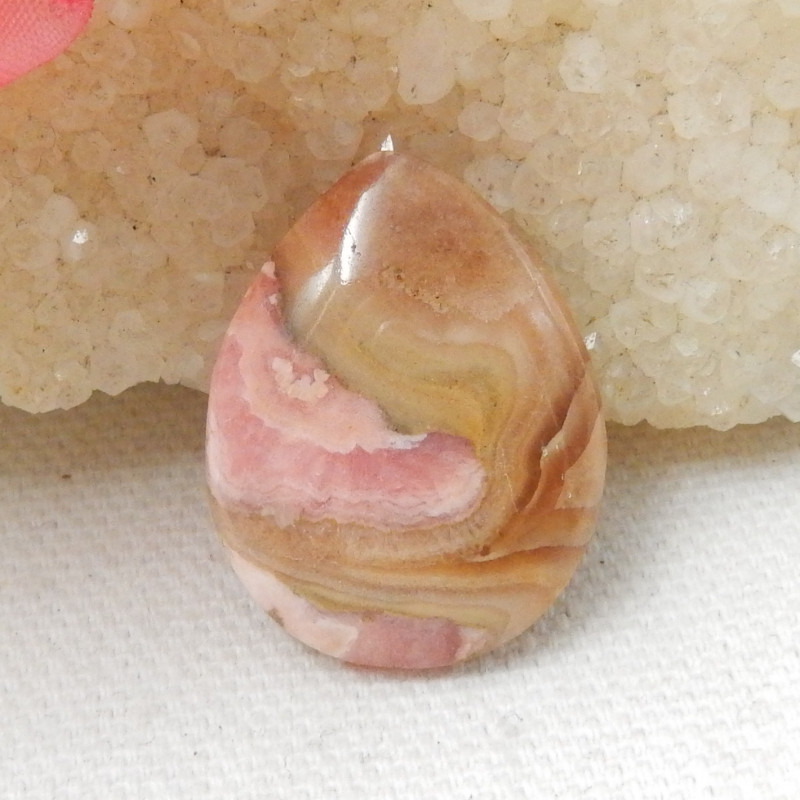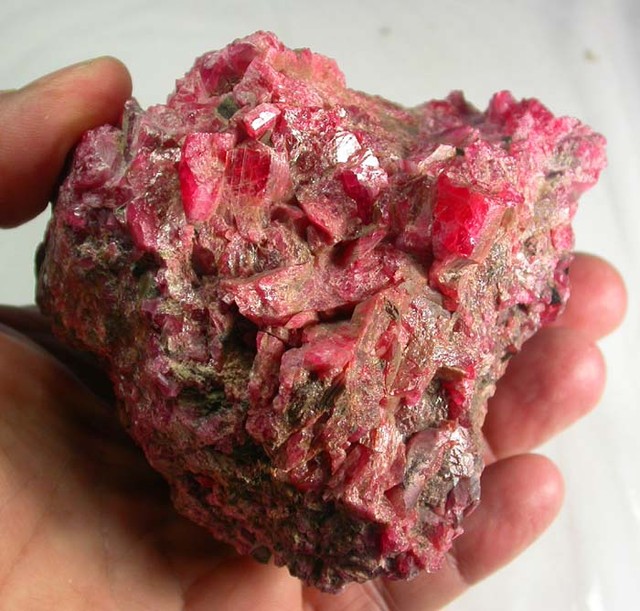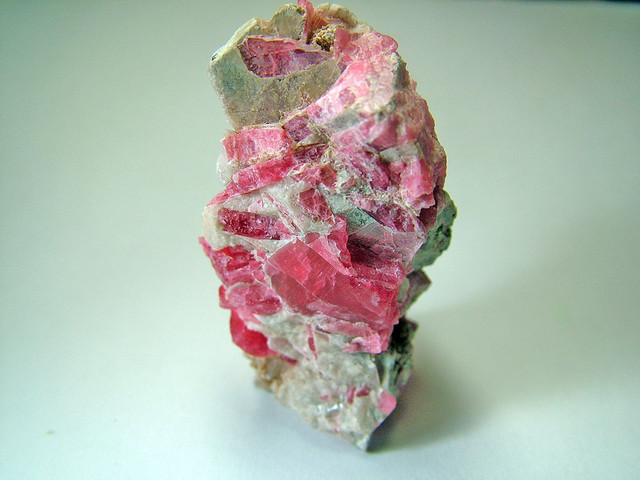
ロードナイト石:意味、治癒効果、用途など
 宝石コレクションは、魅惑的なロードナイトなしでは完成しません。ロードナイトのローズピンクの色合いは、夏の午後の温かく赤らんだ頬を彷彿とさせます。その黒い筋とその希少性が、ロードナイトに深みと魅力を与えています。
宝石コレクションは、魅惑的なロードナイトなしでは完成しません。ロードナイトのローズピンクの色合いは、夏の午後の温かく赤らんだ頬を彷彿とさせます。その黒い筋とその希少性が、ロードナイトに深みと魅力を与えています。
ロードナイトの主な産地の一つであるアメリカは、この石に大きな誇りを持っています。マサチューセッツ州は1979年にロードナイトを州の公式宝石と定めました。しかし、ロシアほどロードナイトに誇りを持つ国はありません。長年にわたりロードナイトの産地として、そして最も豊富であったロシアは、ロードナイトを国の象徴の一つとみなしています。
あなたがどこから来たとしても、ロードナイトの効能、ユニークな外観、象徴性、そして治癒力をきっと楽しめるでしょう。
このガイドでは、鉱物特性から用途、意味、精神的な利点まで、ロードナイト石について知っておくべきすべてのことを説明します。

ロードナイト石とは何ですか?
ロードナイトはマンガンシリカ石で、色はバラ色から深紅色まで様々です。マンガン酸化物の内包物の黒いマトリックスで知られるロードナイトは、他の鉱物との相互作用を恐れません。ロードナイトの内部には、カルシウムから亜鉛まで、様々な元素が混ざり合っていることがあります。
パーティーといえば、あなたの誕生日は牡牛座か蟹座ですか?幸運です!ロードナイトは、この2つの星座にぴったりの現代的な星座石です。伝統的なエメラルドやルビーの誕生石は派手すぎるという方は、ロードナイトの落ち着いたエネルギーをきっと気に入っていただけるでしょう。さらに、ロードナイトは揺るぎない愛を象徴しており、忠誠心と慈悲深さを持つ牡牛座と蟹座の性格にぴったりです。
ロードナイトは誕生石ではありませんが、秋にぴったりです。温かみのある秋の色合いとグラウンディング効果は、大地との繋がりを深め、新しい季節への適応をスムーズにしてくれます。
季節の変化と同じように、ロードナイトの仕様も多少変わることがあります。
ロードナイトの仕様と特徴
ロードナイトはマンガンケイ酸塩鉱物で、弱いながらも多色性やシャトヤンシーといった光学的効果を示すことがあります。マンガンはあらゆる生命体にとって不可欠な鉱物です。マンガンがなければ、私たちは呼吸するための酸素を得ることができません。
「ケイ酸塩」という言葉は、クォーツやトルマリンといった他の宝石でも耳にすることがあるかもしれません。しかし、ロードナイトは輝石グループと呼ばれるケイ酸塩のサブグループに属し、クォーツとトルマリンはそれぞれ異なるグループに属しています。複雑に聞こえるかもしれませんが、それぞれのグループの宝石はそれぞれ異なる化学構造を持ち、それが結晶の形に影響を与えていることを知っておいてください。
化合物:イノケイ酸マンガン(ただし組成は変化する場合がある)
モース硬度: 5.5~6.5
色:バラ色、ピンク、深紅、赤橙、赤褐色、灰色。黒い縞模様が典型的。
結晶構造:三斜晶系
光沢:ガラス質(ガラスのような); 時には真珠のような光沢
透明性:透明から半透明。不透明の場合もある
屈折率: 1.71~1.75
密度: 3.5~3.7
劈開:完全な2方向、プリズマティック
発光:あり; 蛍光; 長波と短波の紫外線の両方

ロードナイトの変種と別名
ロードナイトは、含まれる内包物の種類によって様々な種類があります。例えば、亜鉛を多く含むファウラー石や、この種類のロードナイトが産出されるスウェーデンの都市にちなんで名付けられたパイスベルギトなどがあります。
いくつかの言語では、ロードナイトは独自の名前で呼ばれます。例えば、ロシアではヘルマンナイト、ドイツではカミングトンナイトと呼ばれることがあります。
パイロクスマンジャイトはロードナイトの変種ではなく、多形体です。徹底的な科学的検査を行わない限り、両者を区別することはできません。カルシウムを豊富に含むバスタマイトはロードナイトの別種と考える人もいますが、別の石であると主張する人もいます。
どの種類があなたの好みに合うかにかかわらず、まずは完璧なロードナイト石を購入する際に考慮すべき特性を知る必要があります。
ロードナイト宝石の特性
初めて購入する人でも、長年のコレクターでも、購入する前に石の価値に影響する特性を知っておくことは重要です。
ロードナイトの場合、その主な品質は色、透明度、カットです。
色
ロードナイトがバラ色の赤色で有名であることは、おそらくもうお分かりでしょう。ロードナイトの特徴的な色は、濃い茶色や黒色の内包物です。これらの内包物は、マンガン酸化物によって生じる脈状または色帯のように見えます。
一部のロードナイト石には酸化マンガンが非常に多く含まれており、表面の酸化(錆)によりほぼ完全に黒く見えます。
ロードナイトに含まれる他の内包物も、その色に影響を与えることがあります。例えば、ロードナイトの塊に含まれるバスタマイト内包物は、茶色または赤褐色の斑点を引き起こします。閃亜鉛鉱内包物では小さな緑色の斑点が現れる場合があり、方鉛鉱内包物はより濃い赤褐色を生み出します。
明瞭さ
ほとんどの宝石は、内包物の数と視認性に基づいてクラリティグレードが付けられます。有色宝石には国際的なグレーディング基準はありませんが、米国宝石学会(GIA)は基本的な3段階のシステムを設けています。GIAのシステムに基づくと、透明なロードナイトはタイプIIIに、不透明なロードナイトは不透明(O)に該当します。
タイプIIIの分類が示すように、ロードナイトには多くの内包物が含まれています。内包物は通常、石の価値を下げますが、ロードナイトの内包物は最も魅力的な特性の一つです。透明なロードナイトは非常に希少であるため、縞模様や渦巻き状の内包物を持つ不透明な種類の方が、多くの購入者に人気があります。
ロードナイトに最も多く含まれる内包物は酸化マンガンで、前述の黒い樹枝状結晶として現れます。マグネシウム、カルシウム、鉄もロードナイトには通常含まれています。亜鉛も含まれることがありますが、それほど多くはありません。
カット
ロードナイトは完璧な劈開性を持つため、高度な技術を持つ専門家でなければファセット加工が難しく、繊細な場合が多いです。半透明のロードナイトの宝石やジュエリーも存在しますが、希少性が高く、価格も高くなります。
ロードナイトの一般的なカットとしては、滑らかに磨かれたカボション、タンブルストーン、ビーズなどがあります。また、彫刻やオブジェとしても人気があります。
実際、ロードナイトの歴史は、彫刻に使用できる可能性から始まりました。

ロードナイトの歴史
ロードナイトの歴史は厳密に言えばロシアで始まりました。この石が正式に認められたのは1819年でしたが、ウラル山脈の鉱山労働者たちは1790年から大きな石を採掘していました。
才能豊かなロシアの彫刻家たちは、ロードナイトから様々な素晴らしい作品を制作しました。花瓶、オベリスク、そして皇帝アレクサンドル2世の妻マリア・アレクサンドロヴナの石棺さえも。ロードナイトがロシアの国章とみなされているのも不思議ではありません。
ロシアが外交上の贈り物としてロードナイトの彫刻を送り始めたことで、その人気は世界中で高まりました。やがて、アメリカのティファニー社はマサチューセッツ州産のロードナイトを用いて、ナイフや食器など、洗練されたキッチン用品を製作しました。この鉱山は現在閉鎖されていますが、アメリカ自然史博物館では、そのコレクションの美しい作品を今でも見ることができます。
ロードナイトの歴史に共通する特徴の一つは、お守りとして用いられてきたことです。ロシア皇帝からの贈り物に加え、ウラル山脈の一般の人々も、旅人や新婚夫婦にロードナイトを守りの石として贈り始めました。ギリシャ人やローマ人は長旅の際にロードナイトのお守りを身に着け、身に着けると心拍数が上昇して差し迫った危険を知らせてくれると信じていました。
ロードナイトのスピリチュアルな意味と形而上学的特性は、過去に限定されるものではありません!では、ロードナイトの現在の意味は何でしょうか?
ロードナイト石の意味
ロードナイトは、1819年にドイツの博物学者クリストフ・フリードリヒ・ヤッシェによって正式名称が付けられました。彼は、この石の特徴的なピンクがかった赤色を表現するために、ギリシャ語で「バラ色」を意味する「rhodon 」を用いました。
1819年以前、ロードナイトはロシアでしか知られていませんでした。地元の人々はそれを「鷲の石」を意味するロシア語「オルレッツ」と呼んでいました。伝説によると、住民が鷲の巣の中で小さなロードナイトの破片を見つけたことから、この呼び名が付けられたそうです。また、ロードナイトを赤ちゃんのベビーベッドに入れたり、新米の両親に心を安らげる守護石として贈ったりする地元の伝統も生まれました。
ロードナイトは、その守護力で知られているだけではありません。ロードナイトは自己実現の象徴であり、人生の真の目的を明確にするのに役立ちます。実際、多くのロードナイト愛好家は、その人間的な性質を称賛しています。
ロードナイトはスピリチュアルなエネルギーを持ち、素晴らしいヒーリングストーンとして知られています。ところで、ロードナイトはどのようにヒーリングに活用するのでしょうか?

ロードナイトのスピリチュアルな効果と癒しの効果
スピリチュアルな観点から見ると、ロードナイトは心を癒す様々な作用を持つことから、「慈悲の石」と呼ばれることがよくあります。ロードナイトは、苦しみやトラウマなど、感情に苦しむ人々に力を与えます。
誰かに心を開きたいのに、怖くて仕方がないと感じたことはありませんか?ロードナイトは自信を高め、心の傷を癒すのに役立ちます。さらに、ロードナイトは精神的な明晰さを与え、自分がどこで自分を抑制しているのかに気づかせてくれます。
心を開いている人にとっても、ロードナイトは新たな愛を引き寄せる力があります。また、他人への思いやりを深め、寛大な心を引き出す力も持っています。結局のところ、他人を助けることで、自分の頭から抜け出すことができることもあるのです。
身体的には、ロードナイトは聴覚障害や皮膚疾患に効果があることが知られています。さらに、傷、虫刺され、発疹などの症状に悩まされている方にも効果があります。ロードナイトは記憶力を向上させるとも言われています。
記憶といえば、忘れたい記憶を持つ人もいるかもしれません。もし記憶のせいで感情の壁を築かされているなら、ロードナイトはあなたの心を再び開く力を与えてくれるでしょう。愛を受け入れる心を開くことができれば、ロードナイトはあなたに愛を引き寄せてくれるでしょう。
ロードナイトはどのチャクラに良いのでしょうか? 意外かもしれませんが、ロードナイトはハートチャクラのバランスを整えるのに役立ちます。ハートチャクラのバランスが崩れると、傷つくのが怖くて、外に出て行けなくなってしまうことがあります。ロードナイトを使うと、ハートチャクラが開き、自分自身と周りの人々をより深く愛することができるようになります。

ロードナイトの起源と産地
ロードナイトは、地表または深部において、熱と水が存在する場所で形成されます。このプロセスでは、冷たい岩石が、鉱物を豊富に含む高温の水またはマグマによって化学的に変化します。
ロードナイトの標本のほとんどは、緻密で細粒の塊として発見されます。これらの塊には、バスタマイトやクォーツなどの他の鉱物が混ざっていることがほとんどです。ファセット加工可能な透明なロードナイト結晶を見つけることは稀で、その大きさは2~3カラット程度です。
採掘場所
ロードナイト鉱山は、通常、マンガン鉱石の周辺に位置しています。鉱山の立地条件によって、ロードナイトの塊または透明な結晶が産出されることが知られています。
最も印象的なロードナイトの塊は、ロシア、オーストラリア、スウェーデンから産出されています。スウェーデンは、日本やブラジルと並んで、最高品質の透明ロードナイト結晶を産出しています。その他にも、カナダ、タンザニア、アルゼンチンにも豊富なロードナイトの鉱床があります。
アメリカのどこでロードナイトが採掘されているのでしょうか?マサチューセッツ州はロードナイトを公式の宝石としている唯一の州ですが、ニュージャージー州のフランクリン・ファーネス鉱山は、最盛期に最も象徴的なロードナイトの結晶を産出しました。アメリカのロードナイト鉱床は、他にカリフォルニア州、モンタナ州、コロラド州にも存在します。
自分で宝石探しを楽しむ方なら、「ロードナイトはどうやって見分けるの?」と疑問に思うかもしれません。
ロードナイトの識別
すでに述べたように、ロードナイトは他の似たような石と混同されることがよくあります。ロードナイトが本物かどうかを見分けるにはどうすればよいでしょうか?最も簡単な方法は、ロードナイトと誤って分類されている石の種類と、それらが本物のロードナイトとどう違うのかを知ることです。
ロードクロサイト:ロードクロサイトはロードナイトよりも柔らかいです。ロードクロサイトは塩酸に溶けますが、ロードナイトは溶けません。ロードナイトの脈状模様は黒っぽいのに対し、ロードクロサイトには白い渦巻き状の縞模様があります。
チューライト: チューライトはロードナイトよりも硬く、ロードナイトのような暗い色の縞模様はありません。
ロードライト:ロードライトはガーネットの一種で、ロードナイトはシリカ石です。ロードライトは透明で、一般的に不透明なロードナイトとは異なります。また、ロードライトはロードナイトよりも透明度が高いのも特徴です。
ロードナイトの見分け方を知ることは、探検家にとっても、一般の購入者にとっても役立ちます。ロードナイトの価格と、それに影響を与える要因について考えてみましょう。
ロードナイトの価格と価値
ロードナイトの中でも、大きな結晶や濃い深紅色の標本は最も価値の高いものです。透明なロードナイトの標本は入手困難なため、より高値で取引されます。
1~10カラットの透明で深紅色のロードナイトは、1カラットあたり150~500ドル程度で、より濃い色の石になるとさらに高くなることもあります。10カラットを超える同様のロードナイトは、1カラットあたり500~1,000ドル程度になることもあります。
ロードナイトのジュエリーは今でも手頃な価格で見つけることができますが、不透明のものが主流です。不透明のロードナイトは通常、1カラットあたり0.25ドルから2.50ドルです。シャトヤンシー効果のあるカボションは最も価値が高く、最大5カラットになることもあります。
どの種類を購入する場合でも、適切な洗浄と手入れをすることでロードナイト石を長持ちさせることで、費用対効果を最大限に高めることができます。
ロードナイトのケアとメンテナンス
最も柔らかいロードナイトは透明な種類で、不透明なものは内包物が多いため、より硬くなる傾向があります。透明なロードナイトをお持ちの場合は、取り扱いに特にご注意ください。
どちらの品種でも、ロードナイトに強い衝撃を与えないようにご注意ください。この石は脆く、完全に劈開しているため、ひび割れや破損が生じやすい性質があります。
また、ロードナイト石が以下のものと接触しないように注意してください。
超音波洗浄機
強力な化学物質
猛暑
ロードナイト石の浄化方法としては、次の方法が最も効果的です。
月に2回、石を水流に当ててください。
石をセレナイトまたはアメジストの近くに置いてください。
ロードナイトを土の中に 1 日間埋めておきます。
ロードナイトを月光または日の出の光の下に置きます。

ロードナイトの準備はできていますか?
ロードナイトについて理解が深まった今、この珍しい石がなぜ過小評価されているのかお分かりいただけるでしょう。他の宝石ほど広く流通していないかもしれませんが、だからこそロードナイトは特別で、注目に値するのです。
牡牛座や蟹座としてのプライドを表現したい時も、心の傷を癒したい時も、ロードナイトはきっと力になってくれるでしょう。さらに、ロードナイトのブレスレットや指輪をプレゼントすれば、あなたの寛大な心を引き出してくれるでしょう。
あなたと同じくらいユニークな宝石をお探しですか?今すぐロードナイトを見つけましょう!
Gemstone Encyclopedia検索
最新記事
レインボーラティスサンストーンは、様々な内包物によって3つのゴージャスな光学的効果を持つ長石の一種です。燃えるように鮮やかな色合いと格子模様が、コレクターにとって希少な宝石となっています。
12th Jan 2026
チューライトは、ゾイサイト鉱物ファミリーに属する、鮮やかなバラ色の色合いを示す希少なノルウェー産の宝石で、ジュエリーのセッティングやペンダントによく使用されます。
6th Jan 2026
記事のカテゴリ
How To's is where you will find helpful articles from gem Rock Auctions on how to cut gemstones, select gemstones and buy gemstones.
9記事数

